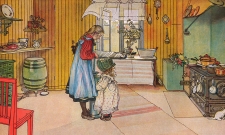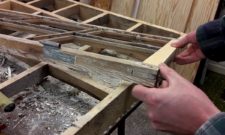Shop our historical maps
Culture
How to renovate old windows step by step

May
Join Stefan J. as he shows you step-by-step how to renovate old windows, from how to remove the glass and scrape off old paint to how to putty windows with real linoleum putty and finally how to paint the new, fresh window frames.
In the video you can see two different windows renovated in the same way. Many people involved in window renovation and building maintenance probably have their own little tricks and ways of doing things, but in general, this is what the window renovation process looks like from start to finish:
- First, remove the old linoleum putty with a scraper or putty knife. It's easier if you heat it first.
- Then the pins that hold the glass in place are loosened, so that it can be lifted out.
- When all the glasses are removed, the paint is scraped off using the heat lamp.
- Then the fittings are removed.
- Now the entire window frame is sanded with sandpaper.
- The lower part of the window arch has rotten wood, which is common with old windows. So Stefan knocks out the wooden dowels that hold the arch together to replace the damaged wood. In this case, it was enough to replace just part of the wood, and new, fresh wood was joined to the old. New wooden dowels are driven in, and now the window renovation continues!
- Fittings are cleaned of old paint and attached to the unpainted window frame.
- The entire window frame is oiled with a coat of raw linseed oil paint. This makes the wood more resistant to moisture and rot, and also saturates the wood, which is important when applying linseed putty. Otherwise, there is a risk that the dry, old wood will soak up the linseed oil in the putty, causing the putty to crack and release from the wood.
- The old window panes are polished and scraped clean of old paint.
- Linoleum putty is placed in the arch underneath where the glass will rest, to make it really tight.
- New glass is cut with a glass cutter.
- The glass is pressed into place and secured with new pins that are hammered in carefully.
- As a final seal, linoleum putty is applied and trimmed with a putty knife.
- Any putty is scraped off the inside of the window.
- Chalk is powdered on the squares to remove grease from the linoleum putty.
- The slots and holes with the wooden plugs in the window frame are also sealed with linoleum putty.
- Finally, the window is painted with three coats of linseed oil paint
Material used in the video:
- Speedheater Cobra heat lamp (also works with a simpler heat gun)
- Paint scrapers from Speedheater and Bahco (a profile scraper comes in handy when renovating windows)
- Crude linseed oil (to impregnate and saturate the wood before painting)
- Linoleum paint from Wibo Färg
- Linoleum putty from Dana
Subscribe to YouTube:
If you appreciate Allmogens independent work to portray our fine Swedish history and Nordic culture, you are welcome to buy something nice in the shop or support us with a voluntary donation. Thank you in advance!
Support Allmogens via Swish: 123 258 97 29
Support Allmogens by becoming a member
Support Allmogens in your will









You can also make your own window putty, which lasts well and is cheaper. I put putty on 105 panes of glass for my glass porch 15 years ago and it has yet to let go or crack.
Take equal parts boiled and raw linseed oil. Start with 0.5 dl of each and you will quickly learn how much putty you need later.
Pour in buckets of chalk powder (you can buy it by the kilo and it doesn't cost much in the paint shop), stir, adding more chalk as you go. Work/ knead the mass until it has the right consistency (test if it 'holds its shape' with the putty knife) and then leave it to rest for a day or so at room temperature.
If you want the putty to be hard, do the same, but only with boiled linseed oil.
Fittings and hooks on old windows are too beautiful to cover with paint. Dismantle them, scrape and sand them completely clean of paint. The surface can have dark and light colour changes, just beautiful !
Brush them with boiled linseed oil and heat them with a hot air gun, lying on a fireproof surface or hanging, until you see the oil start to 'simmer' on the surface. Then the oil will penetrate the iron properly. The result is a very durable semi-gloss hardened finish on the fittings that will not rust.